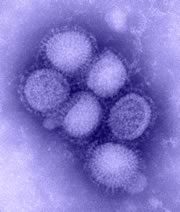

The world is no longer in phase 6 of influenza pandemic alert. We are now moving into the post-pandemic period. The new H1N1 virus has largely run its course.
As we enter the post-pandemic period, this does not mean that the H1N1 virus has gone away. Based on experience with past pandemics, we expect the H1N1 virus to take on the behaviour of a seasonal influenza virus and continue to circulate for some years to come.
According to the Director-General, levels and patterns of H1N1 transmission are now different from those observed during the pandemic. Out-of-season outbreaks are no longer being reported, and their intensity is similar to that seen during seasonal epidemics. In addition, multiple influenza viruses are being isolated in many countries, a pattern typical of many recent seasonal epidemics.
I take particular interest in what the Director-General believes did not happen:
This time around, we have been aided by pure good luck. The virus did not mutate during the pandemic to a more lethal form. Widespread resistance to oseltamivir did not develop. The vaccine proved to be a good match with circulating viruses and showed an excellent safety profile.
I continue to wonder why the Director-General, and many others, feel that influenza virus must change to a more lethal form. Although the four previous influenza pandemics occurred in multiple waves of increasing lethality, there is no evidence that they are a consequence of viral mutation. For example, the only virus available from the 1918 pandemic was rescued from an Alaskan influenza victim who was buried in permafrost in November of that year, when higher mortality was already evident. This makes it impossible to correlate any genetic changes in the virus with increased virulence. Viruses are available from different stages of the pandemics of 1957 and 1968, which also occurred in waves of increasing lethality, but to my knowledge the virulence studies have not been done.
I believe that a major selective force for viral evolution is the need to maintain efficient transmission among hosts. This may be achieved by any number of phenotypic changes, such as increases in stability and virion production. Changes in lethality might also lead to more effective transmission – for example, by inducing more severe coughing, the virus could be better transmitted among humans. But there is no genetic evidence that such changes have occurred during influenza virus pandemics.
How has the idea that influenza virus mutates to greater lethality permeated our popular culture? I don’t know the answer, but John Barry’s The Great Influenza is a prime suspect.

Pingback: [Crof's H5N1] Racaniello on the end of the pandemic | Influenza Virus Mashup
Pingback: Tweets that mention H1N1 pandemic is over -- Topsy.com
Pingback: [Crof's H5N1] Normal H1N1 flu season expected this year | Influenza Virus Mashup
nice theme. but it takes a while to load